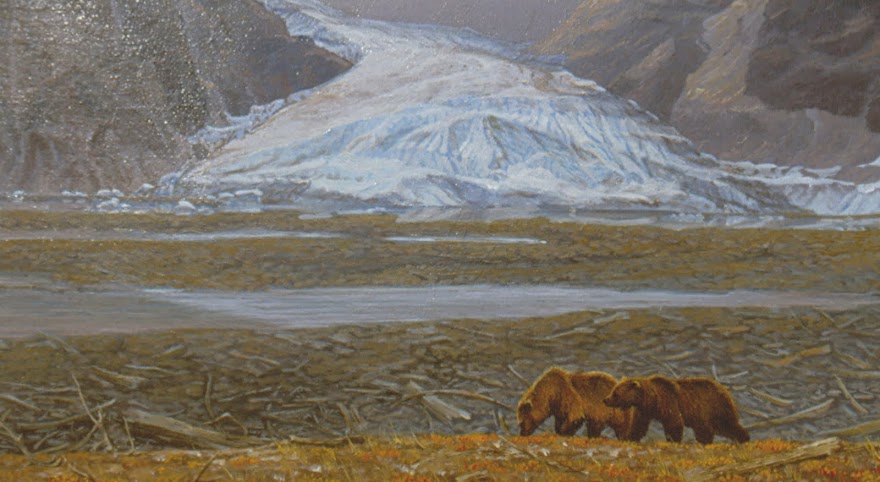The Matsu Valley is not really a valley, it's the name of a large area that surrounds the Matanuska, and Susitna River valleys. This is Sarah Palin country. I'm not very political myself. I get too cynical with politics, and I dont like that. The Matsu Valley starts about 30 miles, northeast of Anchorage, and stretches for many miles into interior Alaska.
 The road to Goose Creek. I saw a Goshawk nearby that day, but it would'nt stick around for a photo.
The road to Goose Creek. I saw a Goshawk nearby that day, but it would'nt stick around for a photo. Typical Fall scenery.
Typical Fall scenery.
Highbush Cranberry leaves.

Mushrooms stacked on top of one another with spider webs.
 More mushrooms, taken earlier in the season.
More mushrooms, taken earlier in the season. The creek still had plenty of rotting salmon.
The creek still had plenty of rotting salmon. Stinking Salmon and fallen leaves.
Stinking Salmon and fallen leaves. This photo is full of forboding, warning of the coming winter. It's a photo of the water with trees and clouds in reflection. The actual sky was not nearly so dramatic, it turned into a sunny day. This is my favorite photo of the day. I shot 160 photos at Goose Creek that day.
This photo is full of forboding, warning of the coming winter. It's a photo of the water with trees and clouds in reflection. The actual sky was not nearly so dramatic, it turned into a sunny day. This is my favorite photo of the day. I shot 160 photos at Goose Creek that day.
This photo was taken last year on the Knik River.
 Another photo of the Knik River. The dusting of snow on the mountains is called Termination Dust. It signals the end of summer. People like me dread the appearance of Termination Dust. Others welcome the snow because they love winter sports.
Another photo of the Knik River. The dusting of snow on the mountains is called Termination Dust. It signals the end of summer. People like me dread the appearance of Termination Dust. Others welcome the snow because they love winter sports. Black Cottonwoods and a small creek along the river bottom. Black Cottonwoods are the largest trees in Southcentral Alaska.
Black Cottonwoods and a small creek along the river bottom. Black Cottonwoods are the largest trees in Southcentral Alaska. A tributary of the Knik Rive
A tributary of the Knik Rive Notice the swans on this pond near the river.
Notice the swans on this pond near the river. The Matanuska River near the town of Palmer. The mountains are part of the Chugach Mountains.
The Matanuska River near the town of Palmer. The mountains are part of the Chugach Mountains. Many miles upriver from Palmer. The river narrows in the canyon next to the Glen Highway.
Many miles upriver from Palmer. The river narrows in the canyon next to the Glen Highway. This is another view of the Matanuska River, just out of Palmer.
This is another view of the Matanuska River, just out of Palmer. The river and King Mountain on the left.
The river and King Mountain on the left. Back on the other side of Palmer, going toward Anchorage. These are the Palmer Hay Flats with Pioneer Peak, and Goat Mountain in the background.
Back on the other side of Palmer, going toward Anchorage. These are the Palmer Hay Flats with Pioneer Peak, and Goat Mountain in the background. Palmer Hay Flats are an important stopover for migrating waterfowl. Many of them stay, and breed here. These are Sandhill Cranes, and a few Mew Gulls.
Palmer Hay Flats are an important stopover for migrating waterfowl. Many of them stay, and breed here. These are Sandhill Cranes, and a few Mew Gulls. Palmer is a good place to see Lesser Sandhill Cranes. They are easily seen in fields around town in Spring, and Fall.
Palmer is a good place to see Lesser Sandhill Cranes. They are easily seen in fields around town in Spring, and Fall.






















